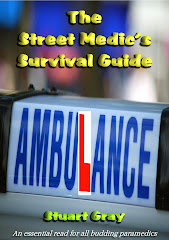 However, in at least six cases over the past few days, where elderly patients have been in slow PEA for quite some time (up to an hour), with CPR ongoing and Adrenaline being given by extremely competent crews, and where the teams in question requested permission to terminate the resus on the basis of futility - not long after it was 'called' and given a time for Recognition of Life Extinct (ROLE), the crews reported a return of spontaneous circulation (ROSC). In other words, shortly after compressions ceased, the patient's heart began to beat. This occurred in every one of those patients despite every causative avenue having been explored prior to cessation of resus and a call, in conference to the Clinical Support Adviser and a senior doctor.
However, in at least six cases over the past few days, where elderly patients have been in slow PEA for quite some time (up to an hour), with CPR ongoing and Adrenaline being given by extremely competent crews, and where the teams in question requested permission to terminate the resus on the basis of futility - not long after it was 'called' and given a time for Recognition of Life Extinct (ROLE), the crews reported a return of spontaneous circulation (ROSC). In other words, shortly after compressions ceased, the patient's heart began to beat. This occurred in every one of those patients despite every causative avenue having been explored prior to cessation of resus and a call, in conference to the Clinical Support Adviser and a senior doctor.Adrenaline, of course, is a major factor here. This hormone can 'make a stone beat', according to one of my doctor colleagues, and I've seen this on many occasions myself (the effect of adrenaline that is), but what I'm thinking about is the possibility that something is happening that could be relevant to the difference between a loved-one dying on the carpet in the front room, or in a hospital bed, with enough time given to say goodbye.
Are we inadvertently creating a ROSC by NOT continuing CPR, or was there a pulse there at the time, during compressions? We continually compress the chest now; there are few pauses and rests, so could there be a reason so many PEA-ROSC outcomes are being recorded?
To be honest, I don't know and I'm hoping that someone out there has had more experience of this and can give me something more to go on than 'it's just one of those things'.
Be safe.








8 comments:
Hello, right, I just left a comment about this and lost it all when I clicked publish, so I'll try again! I've had some similar cases and these are a few of my unsubstantiated thoughts on the matter!
First, l like you thought about the adrenaline kicking in, probably the most likely cause.
Second, what about tension pneumothorax exacerbated or caused by excessive ventilation (though it would hopefully be picked up on some may slip thorough). It would explain the PEA (decreased venous return), would be made worse by ventilation, then the bit I'm unsure on - could it relieve itself on ceasing CPR causing return of circulation to a small extent?
Third - and I'm going into territory a bit beyond me now but have a look at this article written by a professor of trauma at Barts -
http://www.trauma.org/index.php/main/article/361/
(about one third of the way down for the CPR info, the 3rd paragraph of the introduction is also interesting) Though it doesn't deal much with the pre-hospital aspect it raises some interesting points - mainly in this case that in trauma chest compressions can be detrimental. Now I'm not suggesting stopping chest compressions for trauma, but its worth baring in mind (along with the info on drugs and fluid). Now applying this to the point at hand, what if the arrests were due to medically induced trauma (not sure if that's the right phrase?) e.g. tamponade following MI or hypovolaemia following bleeding gastric ulcer. This would certainly indicate why chest compressions were ineffective, could it also be that they are being actively harmful preventing heart from doing its own thing as we jump up and down on it? It doesn't really explain the subsequent ROSC, but maybe there is something there?
You've certainly got me interested now, I'm going to go digging.
Ian
(long time lurker :) love the blog by the way!)
Here we go, did some searching and found this:
http://171.66.127.115/content/100/12/552.full
It seems its a process called the Lazarus phenomenon. The paper suggests it may be as a result of increased pressure from overventilation reducing venous return. Some interesting points, specifically the recovery to discharge of 'lazarus' ROSC patients at 35% (so certainly worth persisting with), the recommendation of breaks in respiration, and of holding back on ROLE for 10 minutes post ceasing CPR - I saw this in an abstract for another paper too, but couldn't get the full text.
Hope this helps some
Ian
Ian
Good man! I saw this stuff out there but I've not had time to search more. I feel lazy but this looks promising.
Thanks mate... I'll keep you up to date if I go forward with this.
Please do! I'd be interested to know what you find. I imagine it is under reported, how often do you re-check for a pulse minutes after stopping, and without support I imagine it would disappear quite quickly!
Ian
Actually, once we've confirmed that CPR should stop, there are no further checks required. It is then a ROLE.
The cases I've had my attention drawn to were incidental sightings of ECG activity, post cessation and during the ROLE process.
In one case the family had already been told their loved one was dead!
I meant it as a rhetorical question ;) as in, we don't check, thus the number of cases found is probably a very small percentage of what actually occurs - especially if the pads are disconnected. Anyway, I look forward to hearing any developments! I'll keep an eye out for anything else relevant.
Ian
Hi,
I've come across a couple of cases where this has happened, including in one patient who was being prepared for the mortuary when it was noticed that ROSC had occurred.
Rich
PEA or EMD? There is a case for portable ultrasound to assist crews with making an informed decision.
If not on every vehicle it could be carried on your FRU/MRU response vehicles.
J.A.M
Post a Comment